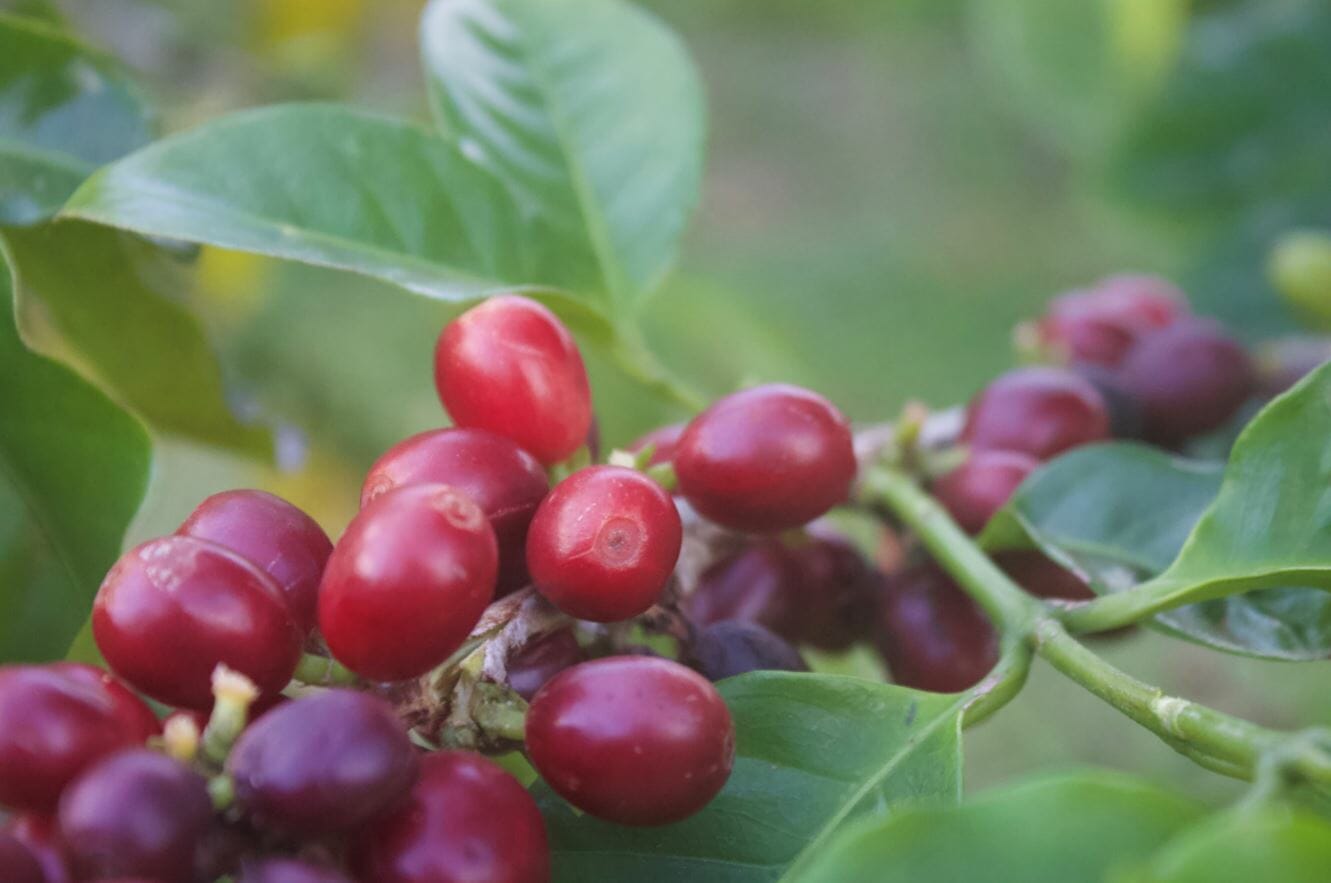Once you have a baseline understanding of what taste is and how to begin tasting specialty coffee you may begin to wonder how coffee becomes so dynamic and what factors influence the taste of coffee. Are you curious why you taste a hint of citrus? Maybe you have begun to identify coffees that are full-bodied and wonder what makes them this way. There are many factors that impact the flavors that end up in your cup. Four of the main influences on taste include environment, processing, roasting, and brewing.
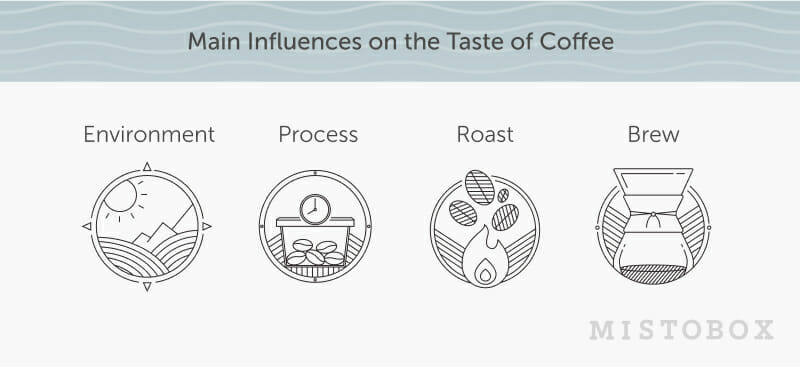
Coffee is the result of an agricultural product grown all over the world and is first affected by the environmental conditions it was grown in. Once harvested, those beans undergo unique processing methods that impact the final product. After processing, the green coffee beans (the agricultural product) undergo the roasting process where different variables like temperature, airflow, batch size, and drum speed decided on by a roaster can either enhance or diminish inherent characteristics within the green coffee. All of these decisions impact the flavor potential of the final product that you buy. This is why you will find information such as Country, altitude, variety, process, and producer on specialty coffee labels. This information can tell us a lot about the coffee and help to determine which brewing method will best enhance the coffee’s natural characteristics. Everything from your chosen brewing method to the grind size of your coffee will affect your perceived flavors, tasting notes, and flavor characteristics in the final brewing stage of the seed to cup journey.
This overview will cover how each of these stages can impact taste and help you, the homebrewer, decide what coffees to buy and how to brew them to get the most out of your cup.
Table of Contents
1. How environment affects taste
2. How processing affects the taste of coffee:
3. How does roast affect taste?
4. How brewing coffee affects taste
1. How Environment Affects the Taste of Coffee

Climate, Soil, & Elevation
Like any other agricultural product, coffee beans are highly impacted by the climate conditions and soil composition of where it is grown. Generally speaking, coffee trees require well-draining, porous soil (volcanic or clay loam), land that is sloped (~15% optimal), and protection from direct sunlight. Direct sunlight can cause stress on the plant and inhibit proper development of the coffee cherry. The optimal climate is humid with consistent rain and weather patterns. This tropical, temperate climate ranges from 60ºF – 80ºF. A climate that is too hot could mean the coffee plant suffers. If the coffee blossoms, cherries, or plants get too cold they may freeze and be destroyed. These specific requirements mean that the number of locations in the world where coffee can be grown is quite limited.
The elevation at which a coffee is grown, measured in meters above sea level (MASL), plays an essential role in developing sugars, acids, and complex flavors that will ultimately lead to a delicious cup of coffee. Generally speaking, coffees grown at lower elevations (and/or warmer climates) often have less acidity and complexity than coffees grown at higher elevations (cooler temperatures). Higher elevations have a wider diurnal variation, meaning warmer daytime temperatures and cooler nighttime temperatures. This dynamic thermal environment is believed to assist coffee cherries in producing more complex acids and sugars during the day, while at night, this development is slowed and the cherry stores them away. The more sugar developed during this ripening process will lead to a sweeter, cleaner and more dynamic flavor profile.
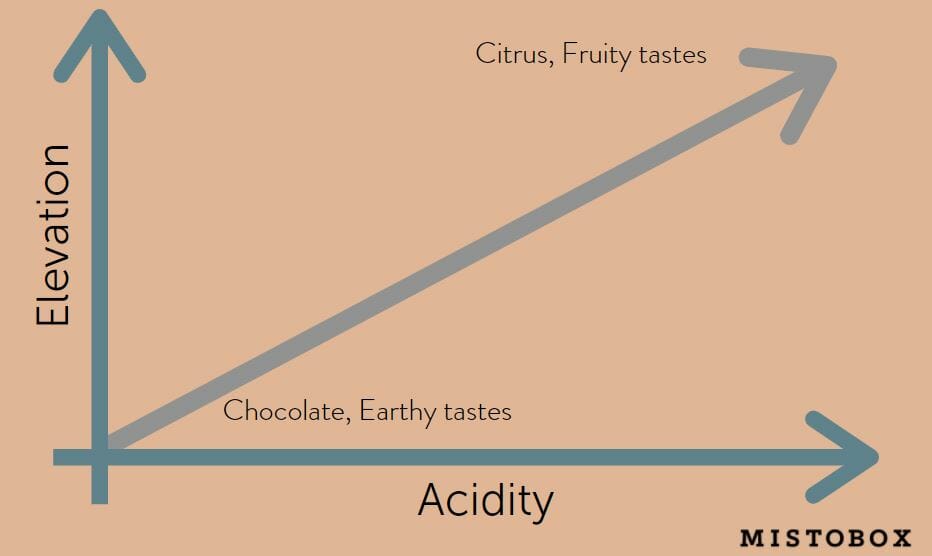
Tip: If you want less acidity look for lower elevations (below 900 meters). If you enjoy acidity (the sparkling sensation on your tongue), look for higher elevation coffees (above 1,000 meters).
Plant Variety or Cultivar
Variety refers to the botanical subspecies of Coffea Arabica, the coffee plant. Variety is often used interchangeably with the word cultivar, which is short for cultivated variety. These subspecies are all arabica coffee but are genetically distinct and can have different complexities, tastes, and thrive in different environments.
To better understand, think of another fruit that is a bit more widely understood, like apples. We’re familiar with different varieties of apples such as fuji, granny smith, gala, and honeycrisp. We know that each type of apple has its own unique color, taste, and texture. The varying levels of acids and sugars help determine what each variety will taste like. Some apples are more tart, while others are sweeter meaning you probably have a favorite type of apple to eat. Coffee is no different.
There are several thousand unique varieties grown throughout Ethiopia (where coffee originated), but fewer than a hundred that are generally grown throughout the rest of the world. Typica (tip-ick-uh) and Bourbon (bur-bone) are two of the most commonly cultivated varieties. Farmers choose to grow certain varieties that thrive in particular environments and consider factors such as yield potential, bean size, quality potential, how tolerant it is to disease, and if it’s susceptible to wind or drought. Some varieties are selectively grown for producing high yield, helping a farmer earn more money, while others are grown due to distinct flavor traits that can help create a higher demand and price for the farmer, like the highly prized Gesha (gay-shuh) variety. Gesha is known for its tea-like qualities, soft citrus acidity, intense floral aromatics, and delicate body. The Bourbon variety is known for its sweetness while the Caturra (cat-ur-uh) variety might have a brighter acidity and less sweetness, comparatively. It is important to remember that the same variety grown in different environments will taste differently.
Country & Region
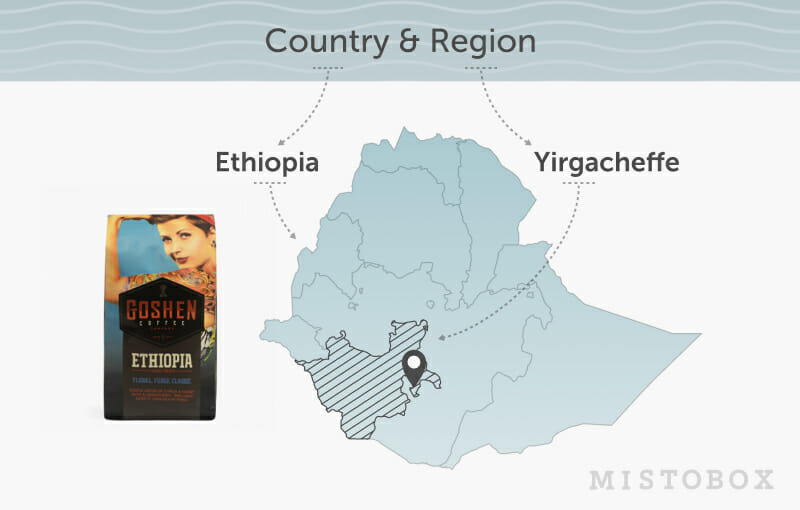
It may seem obvious, but the origin of the coffee has a significant impact on the way your coffee will taste. Beyond similarities of the environment, each country and coffee-growing region has its own infrastructure for growing and selling coffee and often has long-standing traditions for farming, harvesting, and processing techniques.
Coffee generally grows along the Coffee Belt between the Tropic of Cancer and the Tropic of Capricorn where ideal climate conditions exist. This range looks like a belt spanning the figurative waistband of the globe and can generally be broken down into the following origin zones:

Coffees from the Americas
Central American coffees are known for their classic mild and bright flavor profiles. These coffees are grown relatively high in elevation and are largely made up of Bourbon, Typica, and Caturra varieties. As the vast majority of these coffees are processed utilizing the washed method (see processing), these coffees are often distinguished by their bright acidity and round body. They are often considered balanced and clean. South American coffees have something for nearly everyone, as there are a range of flavor profiles from balanced, sweet, and crisp to earthy, rich, and hearty. These coffees have great structure and are solid foundations for a number of blends. If you are looking for a great ‘everyday drinker’ or the perfect coffee to pair with breakfast, look no further than South America.
Coffees from Africa
Coffees from Africa are generally known for their fruity flavors; like blackberry in Kenyan coffees, berry notes in naturally processed Ethiopian coffees, citrus and floral qualities in washed Ethiopians, and jammy qualities in coffees from Rwanda and Burundi. The complex and dynamic flavor profiles of these coffees are just one of the reasons they are so loved and desired in the specialty coffee world.
Coffees from Asia and the Pacific
This area is distinct from other coffee producing regions as the coffee sits at lower altitudes due to the island geography, and domestic cultivation of coffee is considered more of a cash crop grown in backyard gardens as opposed to large farms or estate operations. These coffees generally have a full bodied mouthfeel with intense earthy, herbal, or savory qualities. Indonesia has a reputation for being one of the most intriguing and unique regions in the world, largely due to the Giling Basah (Semi-washed) processing used by many of the local producers. This processing method is what gives Sumatran coffee its distinct earthy quality, low acidity, and heavy body.
2. How processing affects the taste of coffee:

Similar to an apricot or a peach with a pit, coffee is a drupe or stone fruit. Coffee processing is the method by which a coffee’s outer layers of skin, mucilage (the pulpy fruit layer of a coffee cherry) and parchment (the protective layer surrounding each bean) are removed after harvesting and before exporting. After the coffee cherry is picked, the pit or seed is fermented and dried using one of several different processing methods which will drastically impact the flavors.
Washed Process

The washed process or fully washed process requires the coffee seeds (beans) to be removed from the outer layer of the coffee fruit (exocarp) and soaked and fermented in water for several (~12) hours. Water helps remove a sticky mucilage layer (fruit) from the coffee seeds. The seeds are then dried either by laying out to sun dry or by using a mechanical dryer to take the moisture content from 40% down to ~10-12%. The drying process usually takes 6-10 days.

This method generally increases perceived acidity and cleanliness. When tasting, the cup is described as clean, crisp, complex, lively and often exhibits stone fruit and citrus-like flavors (lemon, lime, orange, stone fruit, tropical fruit) with sweet and floral aromas. Browse Washed Process Coffee
Natural Process

During full natural or dry processing, the coffee seeds (beans) are left to dry inside of the coffee fruit and skin. Generally speaking, naturals take a bit longer to dry than washed coffees. Although weather dependent, it will typically take over two weeks to dry natural processed coffees down to a 10-12% moisture content because neither the skin nor the mucilage have been removed. Once dried, the coffee cherries become shriveled and dark brown in color, closely resembling raisins. In some regions, coffee cherries are left to dry on the branches and are picked as “raisins.”
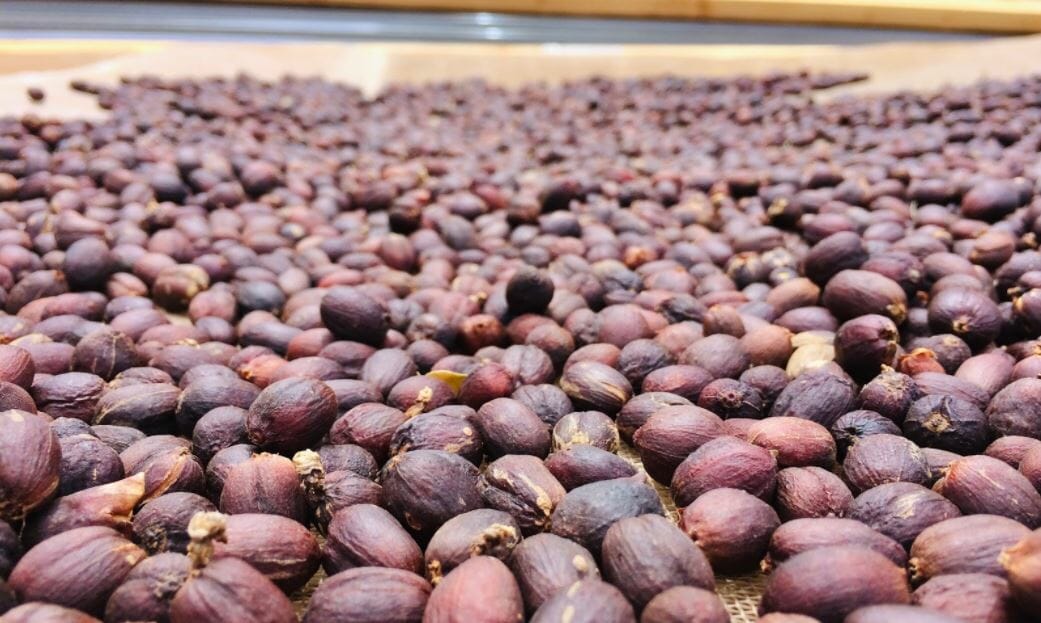
This method usually makes for a very fruity tasting coffee due to the extended contact time with and fermentation inside of the coffee fruit and skin. Acidity tends to be less “bright, crisp, lively” and more “rounded or balanced” with darker berry-like fruit flavors (blueberries, raspberries, strawberries). Browse Natural Process Coffees
Honey Process
We like to think of honey processed coffees as the middle ground between Washed and Naturals. First, the seeds are removed from the fruit skin, then they are laid out to dry with the sticky, honey-like layer (mucilage) still intact. All or part of the fruit pulp or mucilage is allowed to remain on the beans as they dry.
These coffees tend to be sweet, like honey, and complex with a range of different tastes and aromas. Browse Honey Process Coffees
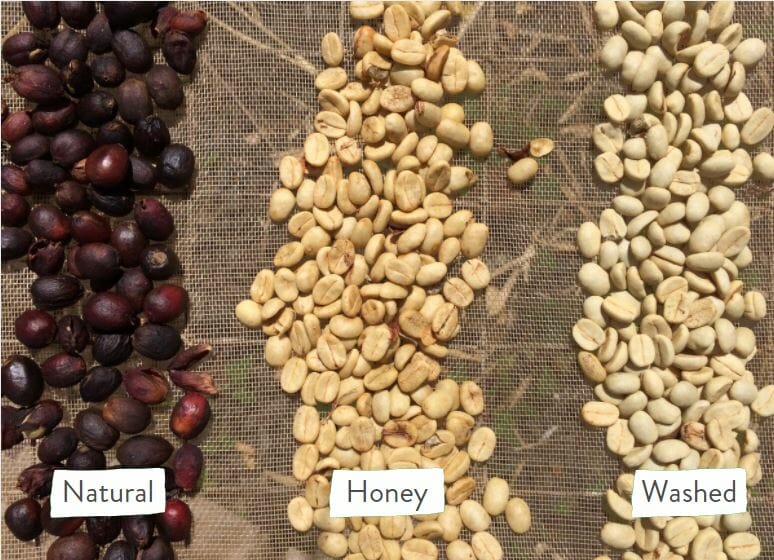
Processing Variations
As coffee producers experiment, new and exciting ways to process coffee have emerged. These are all variations of washed, natural, or honey processed coffees. Examples include semi-washed, anaerobic, and lactic processes, introducing different yeasts to the fermentation process, adding fruits to the drying stage. All of these methods influence the final taste of the coffee in very different ways.
3. How Does Roast Affect Taste?
After processing occurs, green coffee beans are sent to roasters all over the world who use heat to transform it into a consumable product. There are three main designations for roast level ranging from light to dark. Lighter roasts are less roasty/toasty tasting and have more of the raw fruit flavors and aromas intact. Darker roasts have less of the raw inherent flavors and more roasty characteristics. Think of roast level in relation to roasting marshmallows. A lighter roast is less toasty and has more of the raw sugar or plant tastes and aromas intact. A darker roast has less of the raw inherent flavor compounds and more roasty flavor characteristics due to the extended exposure to heat. Medium roasts are a balance retaining some of the natural flavor notes while having some roasty characteristics.
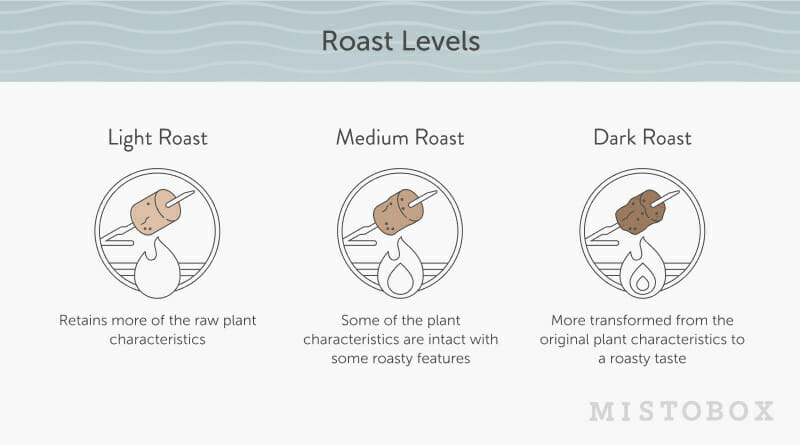
We will go deeper into the roasting process and its effect on coffee next week but for now we can outline the general characteristics of each roast level:
- Light roast coffee:
- More perceived acidity
- Highlights the complex and nuanced flavors inherent to the bean.
- Generally lighter-bodied and lively.
- Why drink a light roast? You like a lively, bright, or nuanced cup of coffee. You want to taste the coffee for what it is and how it was grown and processed.
- Medium roast coffee:
- Combines nuanced flavors inherent to the coffee seeds with roasty caramelized sugars to create a balanced and rich cup.
- Generally offers a balance of chocolate and caramel-like flavor characteristics with soft nuanced citrus or fruit-like acidity.
- Why drink a medium roast? You like a balanced, smooth, complex, or lively cup of coffee.
- Dark roast coffee: roasted to a dark brown color. Oils have surfaced from the amount of heat applied in the roasting process.
- Lower in acidity which is muted and masked by roast characteristics and further caramelization of sugars.
- Why drink a dark roast? You like a rich, bold, or intense cup of coffee. You love the roasty bittersweet flavors that make coffee taste like coffee. If you like your coffee with cream or milk, a dark roast makes the perfect companion.
4. How Brewing Coffee Affects Taste
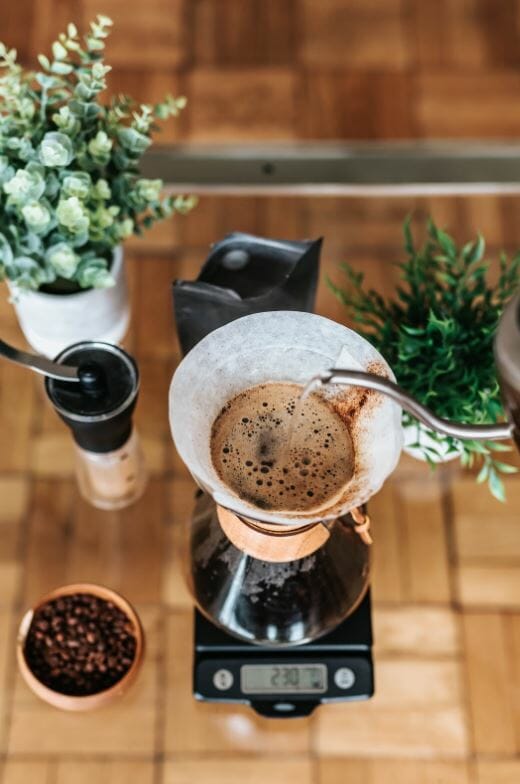
The brewing process is one of the most important steps in producing an excellent cup of coffee. The best quality coffee that was grown, processed, and roasted specifically to your tastes can be disappointing if it isn’t brewed properly. This last stage has 2 main influences which we will discuss in greater detail later on in this series:
- Brewing method: Different brewing methods can have an effect on perceived taste. French press or full immersion methods may taste heavier and more rich compared to pour-over methods. Coffee from a pour-over will taste cleaner and possibly brighter than coffee brewed in a French press. Later in this series, we will deep dive into each brewing method and how to ideally make your perfect cup of coffee.
- Extraction is a term that refers to the brewing process which is where soluble flavors from coffee grounds extract into the water. We are always looking to get an ideal extraction each time by manipulating brewing variables like our coffee to water ratio, the grind size of our coffee, the temperature of our water, and several others we will discuss later in the series.
In summary, coffee is a complex beverage with many factors that influence taste. The four main contributors to how a coffee will taste are the environment it is grown in, how it is processed, its roast profile, and how it is brewed. Do you need to know everything? Absolutely not. Will there always be something more to learn that can help you improve the coffee you choose and the taste of it? Absolutely yes. Better understanding some or even just one of these elements will help you improve the coffee you’re drinking and appreciate it more. This tasting series is meant to be an introduction to tasting specialty coffee that will allow you to go as deep into the information as you desire when you are ready for it.
Learn more about coffee and taste with our series check out our specialty coffee article, guide to coffee cupping or Strong vs Rich vs Bold Coffee: What’s the difference?

